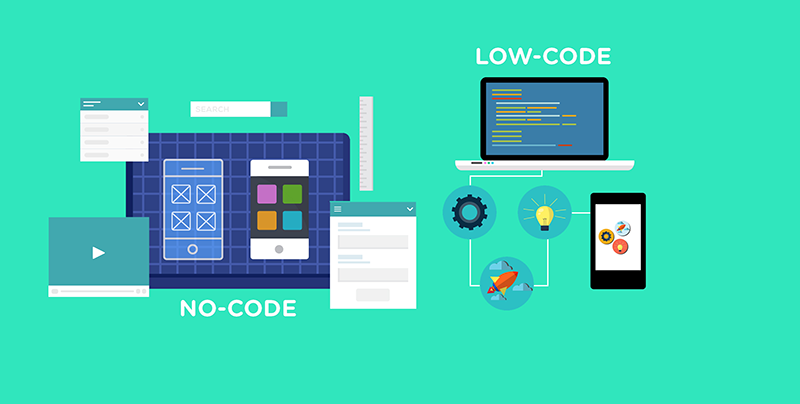

Low-Code and No-Code Platforms — The Future of Software Engineering?


Nowadays, technologies are developing so fast that developers are willing to find some ways to simplify the way of application development but cater to different audiences and use cases. Using low-code and no-code platforms, regular people with basic knowledge of programming can create web and mobile apps. Sounds cool, right? Our specialists’ team gathered some useful info about low-code and no-code platforms for you to understand current trends better. You can also take a look at Introduct’s technologies and developments. So, today we’re going to let you know more about low-code and no-code development and platforms.
What are low-code and no-code development and platforms?
Appealing to a wide range of developers, from professionals to novices, low-code development is a streamlined approach to creating software. With easy-to-use, drag-and-drop interfaces, low-code platforms allow people with limited or no programming experience to efficiently build various web and mobile apps. These tools make software development more automotive and innovative for businesses, at the same time it requires less time and costs. With visual design tools, low-code platforms allow users to build applications without extensive coding. Although some basic programming knowledge is necessary, low-code platforms simplify the application development process and provide guidance and support resources that help companies speed development.
Similar to low-code development and platforms, no-code development speaks for itself. It’s easy to understand that with no-code development, you don’t need any programming knowledge, making it incredibly user-friendly for non-technical individuals. These platforms offer intuitive visual interfaces that accelerate application delivery, promote innovation, and streamline IT operations. Anyone can become a so-called software developer with the help of no-code tools.
Pros of low-code
- Minimum coding experience.
- Increases productivity by streamlining app development.
- Reduces costs.
- Visual building tools with minimal backend code.
- More flexibility with app customization and updates.
Pros of no-code
- Zero coding experience is needed.
- Increases productivity by streamlining app development.
- Reduces costs since no coding is necessary.
- Visual building tools with no backend code.
- Fast and easy build and launch of the app.
Cons of low-code
- Basic coding skills.
- Less secure platforms: They lack security measures.
- Greater costs: Basic coding talent may be needed.
Cons of no-code
- Limited Customization: Templates may restrict app customization.
- Lack of security: Potential security concerns are possible.
- User Experience Oversight: Non-professional app builders may neglect user experience factors.
Where are these Platforms Used Nowadays?
Low-code and no-code platforms have become necessary tools in modern software development, serving businesses, regular citizens, and digital transformation initiatives. For this reason, we suggest you take a look at where exactly these tools are used nowadays:
- Businesses: Used by businesses of all sizes to create apps and reduce costs.
- Small Businesses: Used for custom apps, workflow automation, and website building.
- Large Enterprises: Speed up internal tool development and streamline processes.
- Non-tech users: Popular among non-tech users for app creation and task automation without coding skills.
- Digital Transformation: Essential for rapid adaptation, innovation, and competitiveness in the digital landscape.
What to consider while choosing between platforms?
To choose the correct and suitable platform, it’s important to consider some factors in your software development process:
- Project Complexity: These platforms cope with many cases, but complex applications may require traditional development methods.
- Team Skills: Low-code boosts developer productivity, while no-code empowers non-tech users in development.
- Study the Platform Ecosystem: Make sure it suits your goals and needs.
- Security: Review security measures for protecting sensitive data.
- Tools integration: Make sure the platform integrates with your existing tools and apps.
- Cost Analysis: Examine pricing and licensing structures to fit the budget.
There’s no doubt that low-code and no-code platforms are changing software development, making it easier for users to create new apps easily. Still, these platforms don’t fully replace traditional coding, they cover simple and cost-effective needs. Low-code and no-code tools drive innovation, making the future of software development more simple and less expensive. However, choosing the appropriate platform is crucial for ensuring alignment with long-term goals in the evolving software landscape.
More Articles

Future of Marketing Positions?! Future of Marketing Positions?!
We as a company constantly working on our marketing and our marking team is navigating the ever-evolving landscape, the rise of artificial intelligence (AI) might be sparking questions about the future of marketing team and it’s role in the company.

Anticipating Software Development Trends in 2024 Anticipating Software Development Trends in 2024
As we embark on a new year, the software development landscape continues to evolve at a rapid pace, driven by technological advancements, changing consumer preferences, and emerging industry trends. In this blog post, we’ll explore some of the key software development trends to watch in 2024.
